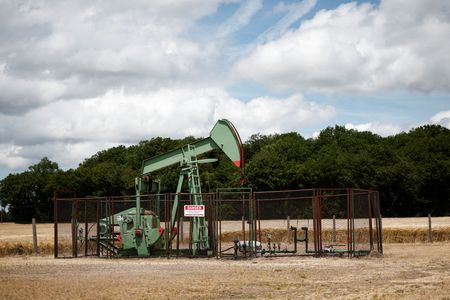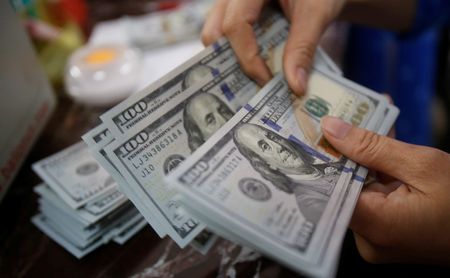By Georgina McCartney
HOUSTON (Reuters) – Oil prices settled down more than 2% on Wednesday after U.S. President Donald Trump took the first big step toward diplomacy over the war in Ukraine he has promised to end, a war that has supported oil prices on concerns about global supplies.
Brent futures settled down $1.82, or 2.36%, at $75.18 a barrel. U.S. West Texas Intermediate (WTI) crude settled down $1.95, or 2.66%, to $71.37.
U.S. crude futures fell more than $2 at their session low. The declines follow three days of gains, during which Brent climbed 3.6% and WTI rose 3.7%.
U.S. President Donald Trump discussed the war in Ukraine in phone calls with Russian President Vladimir Putin and Ukrainian President Volodymyr Zelenskiy.
“Trump doing peace talks, I think that has taken some of the risk premium out of oil prices right now,” said Phil Flynn, senior analyst with Price Futures Group.
In a post on his social media platform, Trump said he and Putin had “agreed to have our respective teams start negotiations immediately, and we will begin by calling President Zelenskiy, of Ukraine, to inform him of the conversation, something which I will be doing right now.”
Zelenskiy’s office said Trump and Zelenskiy had spoken by phone for about an hour.
Investors also tried to gauge the Federal Reserve’s next moves on cutting interest rates following comments on Tuesday by Fed Chair Jerome Powell and after data on Wednesday showed U.S. consumer prices increased more than expected in January.
“The combination of higher inflation and the possibility of peace (in Ukraine) is causing a bit of a sell off in the market at the moment,” said Price Futures Group’s Flynn.
Powell said the economy is in a good place and the Fed is not rushing to cut rates further, but is prepared to do so if inflation drops or the job market weakens.
Consumer price data released by the U.S. Labor Department showed surprisingly strong U.S. inflation in January, stoking fears that a heating economy and looming tariffs could undercut hopes for rate cuts. Higher rates can slow economic activity and dampen demand for oil.
“The inflation numbers came in hot, reducing the chances of the Fed cutting rates from September to December,” said Price Futures Group’s Flynn.
U.S. crude oil stocks posted a larger-than-expected build last week, the Energy Information Administration (EIA) said on Wednesday. Gasoline inventories meanwhile posted a surprise draw while distillate stocks posted a surprise build. Elsewhere, Russia may be forced to throttle back its oil output in the coming months as U.S. sanctions hamper its access to tankers to sail to Asia and Ukrainian drone attacks hobble its refineries.
The Organization of the Petroleum Exporting Countries (OPEC) said in a monthly report that global oil demand will rise by 1.45 million barrels per day (bpd) in 2025 and by 1.43 million bpd in 2026. Both forecasts were unchanged from last month.
The EIA increased its estimate for U.S. crude production while leaving its demand forecast unchanged. It now expects U.S. crude oil output to average 13.59 million bpd in 2025, up from its previous estimate of 13.55 million bpd.
The Trump administration named Kathleen Sgamma, a vocal oil and gas advocate for Western states, to head up the Interior Department’s Bureau of Land Management, which manages the use of the country’s nearly 250 million acres of public lands.
(Reporting by Georgina McCartney in Houston, Colleen Howe, Trixie Yap, Arunima Kumar and Ahmad Ghaddar; Editing by Chizu Nomiyama, David Goodman, Emelia Sithole-Matarise and David Gregorio)











